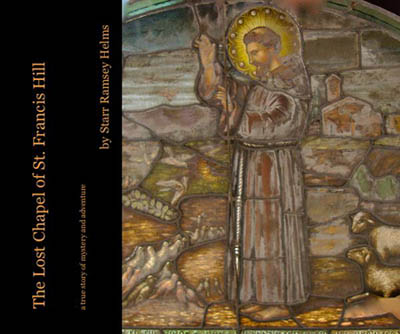A
review for Anglicans Online
by Richard Mammana
A review of
The Lost Chapel of St Francis Hill
By Starr Ramsey Helms
Blurb Creative Publishing Service, 2012. ISBN 9780985100308. 113 pages.
 This new book sets out to answer a practical question: Why is there an 'American Catholic Cathedral' immediately adjacent to St Mary's Church, Laguna Beach, California, a parish of the Episcopal Diocese of Los Angeles? In 2008, Starr Helms, a parishioner of St Mary's Church, began her efforts to find the reasons behind this strange proximity, and she has found a remarkable story of earthquake, schism, a deposed priest, Bette Davis, and congregational rebuilding—both architectural and spiritual.
This new book sets out to answer a practical question: Why is there an 'American Catholic Cathedral' immediately adjacent to St Mary's Church, Laguna Beach, California, a parish of the Episcopal Diocese of Los Angeles? In 2008, Starr Helms, a parishioner of St Mary's Church, began her efforts to find the reasons behind this strange proximity, and she has found a remarkable story of earthquake, schism, a deposed priest, Bette Davis, and congregational rebuilding—both architectural and spiritual.
At the center of the story is an English-born ecclesiastical adventurer named Percy Wise Clarkson (1875-1942). Following emigration to Canada in 1894, Clarkson worked as a stipendiary licensed lay reader in hopes of ordination in the Church of England. Denied holy orders for unknown reasons, he was ordained in the Free Church of England and had become a minister of the Primitive Methodist Church in New Zealand by 1901. Just three years later, despite a checquered history by any measure, he had been ordained to the priesthood in the Anglican Diocese of Wellington. Clarkson saw service in the Gallipoli campaign as an ANZAC padre, and was discharged from Army service in 1916.
Clarkson was received without any apparent curiosity about his background into the Episcopal Church in the United States following arrival in California in 1921. He organized services at the Laguna Beach Country Club, and gathered a congregation sufficient enough to lay the foundation stone of St Francis by the Sea Episcopal Church by 1925. His petition for divorce in 1927 led to his voluntary renunciation of the ministry of the Protestant Episcopal Church, and his affiliation with the Liberal Catholic Church. He, rather than the Episcopal Diocese of Los Angeles, owned the lot on which St Francis by the Sea had been built, and his congregation divided into pro- and anti-Clarkson factions in short order. An anonymous donor broke this impasse by donating funds sufficient to purchase the church building for the anti-Clarkson group, which was in turn admitted to the convention of the Diocese of Los Angeles as a parish in 1931.
Clarkson still, however, owned the lot adjacent to the continuing Episcopal church, which was now renamed St Mary's. By 1934, Clarkson had established the 'Catholic-Episcopal Cathedral Shrine of St Francis by the Sea' on this lot, using as building materials rubble from the 1933 Long Beach Earthquake. In his words:
It is established to outlaw war and is international and interracial. It will specialize in the marrying of people, especially divorced persons, as it is believed that they should have the right to remarry. The church is outside of papal authority and is reputed to be the first to restore to women the right of priesthood. There will be no membership list; no one can 'join.' Ancient wisdom, occult philosophy, reincarnation and comparative religion will be taught.
Clarkson appears at this stage to have reached the strange end of his ecclesiastical wanderings, and the result is the situation of neighbouring churches still visible to visitors to Laguna Beach. Helms follows the after-lives of each congregation, including her own and the still-active St Francis by the Sea, paying special attention to the original chapel constructed by Clarkson. (It was condemned in 1977, and deconsecrated and razed in 1979.) Interestingly, St Mary's continued its public opposition to the remarriage of divorced persons for several decades, earning some notoriety in 1945 for forcing a last-minute change in the wedding plans of the divorcée American actress Bette Davis.
Helms's work is notable for the attractive way in which she takes the reader along step by step in her investigation, and the spirit of curiosity that fills the book. Parish historians and church historians—historians of all kinds, and those who read history, too—will smile with recognition at her characterization of the process of research and writing that has produced such interesting results here.
Historical research is much like mining for gold: you catch a glint of something in the earth, dig down until you find it, clean it off to see if it's a gold nugget or a rock, then dig some more. It's finding the occasional nugget that makes you want to keep digging.